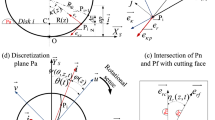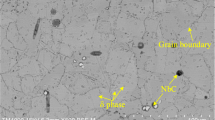Abstract
A simplified procedure is proposed to predict the surface integrity of complex-shape parts generated by ball-end finishing milling. Along a complex cutting path, the tool inclination may vary within a large range. A geometrical study is performed to predict the effect of the tool inclination (lead angle) on the micro-geometry of the machined surface and on the effective cutting speed. This geometrical study brings out a range of values of the lead angle for which the machined surface is damaged by cutting pull-outs. This geometrical study also brings out a range of values of the lead angle for which the effective cutting speed is null. This case corresponds to extreme values of the cutting forces and to high compressive residual stresses. These predictions are verified for a selection of tool inclinations and other cutting parameters such as cutting speed, feed per tooth and cusp height. These machining tests are performed on a high-strength bainitic steel. The experimental campaign includes milling tests with cutting forces measurements, 2-D optical micro-geometry measurements and X-ray diffraction measurements.
Similar content being viewed by others
References
Axinte DA, Dewes RC (2002) Surface integrity of hot work steel after high speed milling-experimental data and empirical models. J Mater Process Tech 127:325–335
Aspinwall DK, Dewes RC, Ng EG, Sage C, Soo SL (2007) The influence of cutter orientation and workpiece angle on machinability when high-speed milling Inconel 718 under finishing conditions. Int J Mach Tool Manufact 47:1839–1846
Rech J, Hamdi H, Valette S (2008) Workpiece surface integrity. In: Davim JP (ed) Machining: fundamentals and recent advances. Springer, London, pp 59–96
Itoga H, Tokaji K, Nakajima M, Ko HN (2003) Effect of roughness on step-wise S-N characteristics in high strength steel. Int J Fatigue 25:379–385
Javidi A, Rieger U, Eichlseder W (2008) Very high cycle fatigue properties of bainitic high carbon-chromium steel. Int J Fatigue 36:2050–2055
Suraratchaï M, Limido J, Mabru C, Chieragatti R (2008) Modelling the influence of machined surface roughness on the fatigue life of aluminium alloys. Int J Fatigue 30:2119–2126
Sasahara H (2005) The effect on fatigue life of residual stress and surface hardness resulting from different cutting conditions of 0.45 % C steel. Int Mach Tool Manufact 45:131–136
Smith S, Melkote SN, Lara-Curzio E, Watkins TR, Allard L, Riester L (2007) Effect of surface integrity of hard turned AISI 52100 steel on fatigue performance. Mat Sci Eng A-Struct 459:337–346
Hamdi H, Zahouani H, Bergheau JM (2004) Residual stresses computation in a grinding process. J Mater Process Tech 147:277–285
Outeiro JC, Umbrello D, M'Saoubi R (2006) Experimental and numerical modelling of the residual stresses induced in orthogonal cutting of AISI 316 L steel. Int Mach Tool Manufact 46:1786–1794
Kalvoda T, Hwang YR (2009) Impact of various ball cutter tool positions on the surface integrity of low carbon steel. Mater Design 30:3360–3366
Bouzid Saï W, Ben Salah N, Lebrun JL (2001) Influence of machining by finishing milling on surface characteristics. Int Mach Tool Manufact 41:443–450
Novovic D, Dewes RC, Aspinwall DK, Voice W, Bowen P (2003) The effect of machined topography and integrity on fatigue life. Int Mach Tool Manufact 44:125–134
Pessard E, Morel F, Morel A (2008). The anisotropic fatigue behaviour of forged steel. Proceedings of 12th International Spring Meeting of the SF2M, Paris, France
Quinsat Y, Sabourin L, Gogu G (2004) Help for sculptured surface machining strategy choice: application to finishing process. Current Advances in Mechanical design and production 8:1023–1032
Jung YH, Kim JS, Hwang SM (2001) Chip load prediction in ball-end milling. J Mat Process Tech 111:250–255
Leach R (2010) Fundamental principles of engineering nanometrology. Elsevier, Oxford
Quinsat Y, Sabourin L, Lartigue C (2008) Surface topography in ball end milling process: description of a 3D surface roughness parameter. J Mat Process Tech 95:135–143
NF EN ISO 25178-2/NF E05-030-2PR (2008) Spécification géométrique des produits (GPS). États de surface : surfacique. Partie 2: Termes, définitions et paramètres d'états de surface
François M, Sprauel JM, Déhan CF, James MR, Convert F, Lu J, Lebrun JL, Ji N, Hendricks RW (1996) X-ray diffraction method. In: Lu J (ed) Handbook of measurement of residual stresses, Society for Experimental Mechanics. The Fermont Press, Lilburn
Arola D, Williams CL (2002) Estimating the fatigue stress concentration factor of machined surfaces. Int J Fatigue 24:923–930
Pina J, Dias A, François M, Lebrun JL (1997) Residual stresses and crystallographic texture in hard-chromium electroplated coatings. Surf Coat Tech 96:148–162
Souto-Lebel A, Guillemot N, Lartigue C, Billardon R (2011) Characterization and influence of defect size distribution induced by ball-end finishing milling on fatigue life. In: 1st CIRP Conference on Surface Integrity (CSI). Procedia Engineering 19:343–348
Author information
Authors and Affiliations
Corresponding author
Rights and permissions
About this article
Cite this article
Guillemot, N., Mawussi, B.K., Lartigue, C. et al. A first approach to characterize the surface integrity generated by ball-end finishing milling. Int J Adv Manuf Technol 64, 269–279 (2013). https://doi.org/10.1007/s00170-012-4017-3
Received:
Accepted:
Published:
Issue Date:
DOI: https://doi.org/10.1007/s00170-012-4017-3




